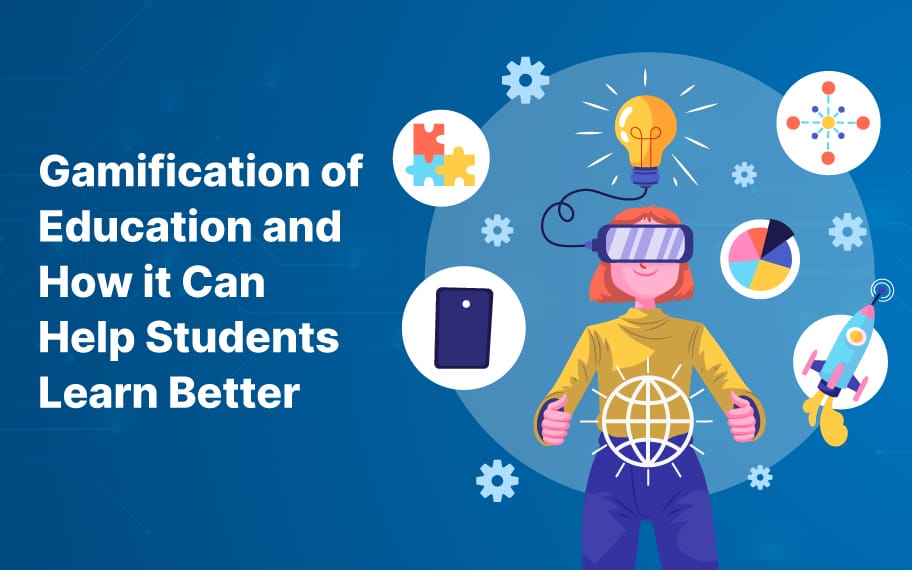In today’s day and age of remarkable competition and pace, educational institutions are increasingly turning towards alternative options of making learning environments enjoyable and engaging. Gamification is a prominent and increasingly popular means to this end. This is not surprising – just look at the affinity for video games amongst all the children around us. As per a recent study on gamification trends, education has emerged as the second largest adopter of gamified solutions, after retail.
What is Gamification in Education?
Gamification is the application of game elements, such as competition, rewards, and interactive design, to learning environments, with the aim of enhancing engagement and motivation. Gamification as a way to impart learning has been in use even in the olden times with teachers using games and hands-on activities for this purpose. In today’s context, technology has made gamification immensely impactful and entertaining by bringing imagination to life! The core idea is to leverage the inherent appeal of games to foster a positive and immersive learning environment. This elevated learning environment, in turn, brings desired behavioural changes amongst students and helps achieve specific outcomes. Gamification has to be used in conjunction with the traditional text-based lessons for maximum impact; the right mix can really accelerate comprehensive learning!
How can gamification benefit education?
1. Increased Engagement:
Gamification captivates students' attention by introducing elements like challenges, quests, and rewards, making the learning process more engaging and enjoyable. This increased engagement leads to higher levels of participation and active involvement in learning activities, both inside and outside the classroom.
2. Intrinsic Motivation:
By incorporating elements such as achievements, badges, and levels, gamification taps into students' intrinsic motivation. This intrinsic motivation, driven by a desire to achieve goals within the game, creates a genuine interest in learning the subject matter. There is an element of healthy competition through “ranks” in the games which encourage the students to strive for more
3. Enhanced Collaboration:
Many educational games encourage collaboration and teamwork, fostering a sense of community. Whether it's through multiplayer games or collaborative quests, gamification promotes peer interactions. In addition, you can have participants from all over the world with different backgrounds. Children mingle and collaborate with global team members, with diverse backgrounds, from a very young age. These are essential skills for success in the real world.
4. Immediate Feedback:
Games often provide instant feedback on performance, allowing students to learn from their mistakes and make improvements. This feedback loop enhances the learning process and helps students understand and retain information more effectively. The practical aspect of gamification promotes easier retention of the feedback – verbal feedback about performance in theoretical tests and assessments is comparatively difficult to assimilate and internalise.
5. Customized Learning Paths:
Gamification allows for personalized learning experiences, as students’ progress through levels at their own pace. Adaptive learning systems can adjust the difficulty of tasks, ensuring that each student is challenged appropriately. This means that the student can progress at the right pace for her/him and also learn along paths that are more suitable e.g., a student naturally inclined towards arts can get to work on games involving paintings while another student geared towards engineering can get to play video games involving construction of buildings!
6. Enhanced Cognitive Development:
As a child grows her/his ability to pick up new things increases, they make sense of what they learnt, correlate them and apply for results. Gamification expands the imagination and promotes greater retention of knowledge by enabling practical, tangible experiences. Games boost brain skills and elevate cerebral power.
Strategies / Examples to Implement Gamification in the Classroom
1. Points and Badges:
This includes a point system where students earn points for completing assignments, participating in discussions, or achieving certain milestones. Using this with badges or certificates to acknowledge their accomplishments is very effective. This simple gamification element can boost motivation and create a sense of achievement.
2. Leaderboards:
Implementing a leaderboard system can introduce an element of healthy competition. Students can earn points for academic achievements, and their progress can be displayed on a leaderboard. This fosters a sense of accomplishment and encourages friendly competition, driving students to excel.
3. Quests and Challenges:
This involves designing educational quests or challenges that students must complete to advance in the learning journey. It’s almost like simulating levels in a video game! These quests can be tied to specific learning objectives including analytical problem-solving, research assignments, or creative projects. The excitement and sense of accomplishment associated with completing quests enhances motivation.
4. Simulation Games:
Simulation games to immerse students in real-world scenarios, pertaining to the subject matter, can be very effective For instance, a biology class could utilize a VR-based tour inside the human body. This approach not only makes learning fun but also promotes retentivity of learning.
5. Escape Room Activities:
This includes organizing virtual or physical escape room activities where students work together to solve puzzles. This collaborative approach promotes teamwork, critical thinking, and problem-solving skills.
6. Interactive Learning Apps:
Learning apps that utilize gamification elements can offer quizzes, challenges, and interactive content to reinforce lessons. Many educational apps also include progress tracking features, allowing students to monitor their advancement.
7. Role-Playing Games:
This is about designing role-playing games where students take on specific roles related to the subject matter. Whether it's historical figures, scientific concepts, or literary characters, role-playing can make learning more immersive and enjoyable.
Conclusion
Gamification in education represents a promising frontier for educators seeking to create dynamic and engaging learning environments. The ability to personalize learning provides the all-important edge to the core proposition of gamification through immersive digital methods. By harnessing the power of game design principles, educators can tap into students' natural inclination for play and competition, turning the learning process into a rewarding and enjoyable experience, not just to further the academic pursuits but to also promote their co-curricular pursuits.
Learn more about Teachmint plans here.





